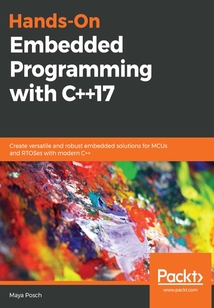舉報 

會員
Hands-On Embedded Programming with C++17
C++isagreatchoiceforembeddeddevelopment,mostnotably,becauseitdoesnotaddanybloat,extendsmaintainability,andoffersmanyadvantagesoverdifferentprogramminglanguages.Hands-OnEmbeddedProgrammingwithC++17willshowyouhowC++canbeusedtobuildrobustandconcurrentsystemsthatleveragetheavailablehardwareresources.StartingwithaprimeronembeddedprogrammingandthelatestfeaturesofC++17,thebooktakesyouthroughvariousfacetsofgoodprogramming.You’lllearnhowtousetheconcurrency,memorymanagement,andfunctionalprogrammingfeaturesofC++tobuildembeddedsystems.Youwillunderstandhowtointegrateyoursystemswithexternalperipheralsandefficientwaysofworkingwithdrivers.Thisbookwillalsoguideyouintestingandoptimizingcodeforbetterperformanceandimplementingusefuldesignpatterns.Asanadditionalbenefit,youwillseehowtoworkwithQt,thepopularGUIlibraryusedforbuildingembeddedsystems.Bytheendofthebook,youwillhavegainedtheconfidencetouseC++forembeddedprogramming.
目錄(217章)
倒序
- coverpage
- Title Page
- Copyright and Credits
- Hands-On Embedded Programming with C++17
- About Packt
- Why subscribe?
- Packt.com
- Contributors
- About the author
- About the reviewers
- Packt is searching for authors like you
- Preface
- Who this book is for
- What this book covers
- To get the most out of this book
- Download the example code files
- Conventions used
- Get in touch
- Reviews
- Section 1: The Fundamentals - Embedded programming and the role of C++
- What Are Embedded Systems?
- The many faces of embedded systems
- Microcontrollers
- TMS 1000
- Intel MCS-48
- Intel MCS-51
- PIC
- AVR
- M68k and Z80-based
- ARM Cortex-M
- H8 (SuperH)
- ESP8266/ESP32
- Others
- Challenges
- System-on-Chip/Single Board Computer
- Challenges
- Summary
- C++ as an Embedded Language
- C++ relative to C
- C++ as an embedded language
- C++ language features
- Namespaces
- Strongly typed
- Type conversions
- Classes
- Inheritance
- Virtual base classes
- Function inlining
- Runtime type information
- Exception handling
- Templates
- The standard template library
- Maintainability
- Summary
- Developing for Embedded Linux and Similar Systems
- Embedded operating systems
- Real-time OSes
- Custom peripherals and drivers
- Adding an RTC
- Custom drivers
- Resource limitations
- Example – club room monitoring
- Hardware
- Relays
- Debounce
- Debounce HAT
- Power
- Implementation
- Listener
- Club
- HTTP request handler
- Status handler
- Data handler
- Service configuration
- Permissions
- Final results
- Example – basic media player
- Summary
- Resource-Restricted Embedded Systems
- The big picture for small systems
- Example – Machine controller for a laser cutter
- Functional specification
- The design requirements
- Implementation-related choices
- Embedded IDEs and frameworks
- Programming MCUs
- Memory programming and device debugging
- Boot loader
- Memory management
- Stack and heap
- Interrupts ESP8266 IRAM_ATTR
- Concurrency
- AVR development with Nodate
- Enter Nodate
- Example – CMOS IC Tester
- Usage
- ESP8266 development with Sming
- ARM MCU development
- RTOS usage
- Summary
- Example - Soil Humidity Monitor with Wi-Fi
- Keeping plants happy
- Our solution
- The hardware
- The firmware
- Setting up Sming
- Plant module code
- Makefile-user.mk
- Main
- OtaCore
- BaseModule
- PlantModule
- Index.html
- Compiling and flashing
- First-time configuration
- Using the system
- Taking it further
- Complications
- Summary
- Section 2: Testing Monitoring
- Testing OS-Based Applications
- Avoiding real hardware
- Cross-compiling for SBCs
- Integration test for club status service
- Mock versus hardware
- Testing with Valgrind
- Multi-target build system
- Remote testing on real hardware
- Summary
- Testing Resource-Restricted Platforms
- Reducing wear
- Planning out a design
- Platform-independent build systems
- Using cross-compilers
- Local and on-chip debugging
- Example – ESP8266 integration test
- The server
- Makefile
- The node
- Makefile
- Building the project
- Summary
- Example - Linux-Based Infotainment System
- One box that does everything
- Hardware needed
- Software requirements
- Bluetooth audio sources and sinks
- Online streaming
- Voice-driven user interface
- Usage scenarios
- Source code
- Building the project
- Extending the system
- Summary
- Example - Building Monitoring and Control
- Plants rooms and beyond
- Developmental history
- Functional modules
- Firmware source
- Core
- Modules
- CO2 module
- Jura
- JuraTerm
- Motion
- PWM
- I/O
- Switch
- Command and control server
- Administration tool
- Air-conditioning service
- InfluxDB for recording sensor readings
- Security aspects
- Future developments
- Summary
- Section 3: Integration with other tools and frameworks
- Developing Embedded Systems with Qt
- The power of the right framework
- Qt for command-line use
- GUI-based Qt applications
- Embedded Qt
- Custom GUIs with stylesheets
- QML
- 3D designer
- An example of adding a GUI to the infotainment system
- Main
- QmlInterface
- QML
- Summary
- Developing for Hybrid SoC/FPGA Systems
- Going extremely parallel
- Hardware description languages
- FPGA architecture
- Hybrid FPGA/SoC chips
- Example – basic oscilloscope
- The hardware
- The VHDL code
- The C++ code
- Building the project
- Summary
- Best Practices
- All the best-laid plans
- Working with the hardware
- The confusing world of peripherals
- Knowing your tools
- Choosing asynchronous methods
- Reading the datasheet
- Keeping interrupt handlers short
- 8-bit means 8 bits
- Don't reinvent the wheel
- Think before you optimize
- Requirements are not optional
- Documentation saves lives
- Testing code means trying to destroy it
- Summary
- Other Books You May Enjoy
- Leave a review - let other readers know what you think 更新時間:2021-08-20 10:21:17
推薦閱讀
- Applied Unsupervised Learning with R
- 嵌入式技術基礎與實踐(第5版)
- 硬件產品經理成長手記(全彩)
- OpenGL Game Development By Example
- 龍芯自主可信計算及應用
- BeagleBone Robotic Projects
- Hands-On Motion Graphics with Adobe After Effects CC
- 新編電腦組裝與硬件維修從入門到精通
- FL Studio Cookbook
- The Artificial Intelligence Infrastructure Workshop
- 觸摸屏應用技術從入門到精通
- USB應用開發寶典
- Raspberry Pi Home Automation with Arduino
- PIC系列單片機的流碼編程
- Learning Microsoft Cognitive Services
- Hands-On Embedded Programming with C++17
- 數據恢復與硬盤修理
- 微處理器及控制電路識圖
- 101 UX Principles
- FPGA設計技巧與案例開發詳解
- 勇敢的芯伴你玩轉Nios II(電子設計與嵌入式開發實踐叢書)
- MCU工程師煉成記:我和MSP430單片機
- CANoe開發從入門到精通
- 阿里巴巴Java開發手冊(第2版)
- 32位嵌入式微處理器原理及應用
- Arduino實戰手冊:25個精選實例帶你輕松入門(彩色圖解版)
- PySide GUI Application Development
- OpenSceneGraph 3 Cookbook
- Building Forms with Vue.js
- STC單片機原理及應用:從器件、匯編、C到操作系統的分析和設計(立體化教程)(第2版)

